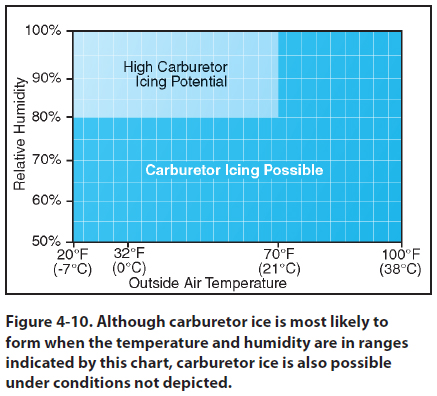|
Chapter 4 — Powerplants
Four-Stroke Mixture Settings
Four-stroke engines typically have automatic mixture
control for higher altitudes or a mixture control that
can be operated by the pilot.
Carburetor Icing
One disadvantage of the carburetor system versus the
fuel injected system is its icing tendency. Carburetor
ice occurs due to the effect of fuel vaporization
and the decrease in air pressure in the venturi, which
causes a sharp temperature drop in the carburetor. If
water vapor in the air condenses when the carburetor
temperature is at or below freezing, ice may form
on internal surfaces of the carburetor, including the
throttle valve.
Ice generally forms in the vicinity of the venturi throat.
This restricts the flow of the fuel-air mixture and reduces
power. If enough ice builds up, the engine may
cease to operate. Carburetor ice is most likely to occur
when temperatures are below 70°F (21°C) and the
relative humidity is above 80 percent. However, due
to the sudden cooling that takes place in the carburetor,
icing can occur even with temperatures as high
as 100°F (38°C) and humidity as low as 50 percent.
This temperature drop can be as much as 60 to 70°F.
Therefore, at an outside air temperature of 100°F, a
temperature drop of 70°F results in an air temperature
in the carburetor of 30°F. [Figure 4-10]

The first indication of carburetor icing in a powered
parachute is a decrease in engine RPM, which may be
followed by engine roughness. Although carburetor
ice can occur during any phase of flight, it is particularly
dangerous when using reduced power during a
descent. Under certain conditions, carburetor ice could
build unnoticed until you try to add power. To combat
the effects of carburetor ice, some engines have a carb
heat option. Some of the newer four-stroke engines
have carburetor heat turned on all the time to combat
icing. Two-stroke engines are typically less susceptible
to icing but specific installations dictate how susceptible
the carburetor is to icing. Consult the aircraft
POH for the probability of carb ice for the specific
installation you have and for carb ice procedures.
Fuel Injection Systems
In a fuel injection system, the fuel is injected either
directly into the cylinders, or just ahead of the intake
valve. A fuel injection system usually incorporates
these basic components: an engine-driven fuel pump,
a fuel-air control unit, fuel manifold (fuel distributor),
discharge nozzles, an auxiliary fuel pump, and fuel
pressure/flow indicators. [Figure 4-11]

The auxiliary fuel pump provides fuel under pressure
to the fuel-air control unit for engine starting and/or
emergency use. After starting, the engine-driven fuel
pump provides fuel under pressure from the fuel tank
to the fuel-air control unit. This control unit, which
essentially replaces the carburetor, meters the fuel and
sends it to the fuel manifold valve at a rate controlled
by the throttle. After reaching the fuel manifold valve,
the fuel is distributed to the individual fuel discharge
nozzles. The discharge nozzles, which are located in
each cylinder head, inject the fuel-air mixture directly
into each cylinder intake port.
Some of the advantages of fuel injection are:
• No carburetor icing.
• Better fuel flow.
• Faster throttle response.
• Precise control of mixture.
• Better fuel distribution.
• Easier cold weather starts.
Disadvantages include:
• Difficulty in starting a hot engine.
• Vapor locks during ground operations on hot
days.
• Problems associated with restarting an engine
that quits because of fuel starvation.
|

